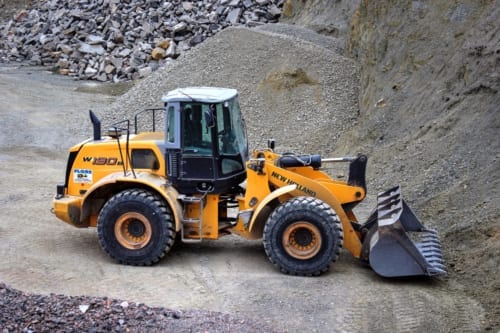Innovation still to come
by Robert Harris
 At a fundamental level, the enterprise of k-12 public education in the U.S. has much in common with the construction aggregate industry both in its method of production and the outcomes it achieves. In a commercial rock quarry that produces aggregate (the stones used for building material), very large boulders are lifted by huge cranes and other massive earth-moving machinery and dropped into powerful jaw- and cone-crushers to reduce them into various smaller workable sizes and shapes. Once these stones are processed into smaller fragments, they are placed onto conveyors that transport them to a screening apparatus where they are sorted by size, shape and weight.
At a fundamental level, the enterprise of k-12 public education in the U.S. has much in common with the construction aggregate industry both in its method of production and the outcomes it achieves. In a commercial rock quarry that produces aggregate (the stones used for building material), very large boulders are lifted by huge cranes and other massive earth-moving machinery and dropped into powerful jaw- and cone-crushers to reduce them into various smaller workable sizes and shapes. Once these stones are processed into smaller fragments, they are placed onto conveyors that transport them to a screening apparatus where they are sorted by size, shape and weight.
In the final phase of production, these stones are washed and classified by their physical characteristics for use in different industries. The largest stones are used for making foundations, smaller stones are used for drainage, even smaller ones are used to produce gravel for road construction, and even the last spec of powder does not go to waste as it will be used for making cement.
Like stones in a commercial rock quarry, students who attend today’s k-12 public schools in the U.S. are being crushed by an extraordinarily heavy workload, fragmented by academic and social pressures, and placed on conveyors from one classroom to the next only to be screened and sorted by exams and standardized tests which ultimately pulverize them into the aggregate used to create a stable foundation for our society.
This process is a result of approximately 100 years of continuous improvement. Thousands of years ago, it was the Roman Empire that first developed technology for the mass production of aggregate. They used this technology to build roads and bridges that would lead to opportunities for future commerce and conquest. However, unlike in Roman times, if the current system of education continues to mass produce students like the aggregate mined in a rock quarry, the foundation upon which our society is built will not support the roadways and bridges needed to transport our children to the future world they will live in.
 Make no mistake about it, k-12 public schools in the U.S. remain as one of the most effective sorting and screening tools available to mankind for stratifying society. In fact, if you like the way it operates, it’s the best taxpayer dollars can buy. Under the current system, before a child even sets one foot in a classroom, the screening and sorting process begins. Now labeled a student with a unique identification number, the child is systematically assigned to a ‘class’ and ‘grade’ based on his chronological age and the geographic location of his parent’s or guardian’s primary residence.
Make no mistake about it, k-12 public schools in the U.S. remain as one of the most effective sorting and screening tools available to mankind for stratifying society. In fact, if you like the way it operates, it’s the best taxpayer dollars can buy. Under the current system, before a child even sets one foot in a classroom, the screening and sorting process begins. Now labeled a student with a unique identification number, the child is systematically assigned to a ‘class’ and ‘grade’ based on his chronological age and the geographic location of his parent’s or guardian’s primary residence.
The child, now a student, is then methodically and, oft times, meticulously screened and tested by nurses, teachers, counselors, and psychologists to assess his physical, social and intellectual readiness to begin his schooling. Given the similarity between schools and the aggregate industry, I am surprised that a geologist is not involved in this process.
In some cases, the preliminary results of this initial screening can pre-determine a child’s entire k-12 learning experience and perhaps his life’s destiny. School systems, as they have existed in the U.S. since the early 20th century, continue to drive uniqueness to sameness. The kindergarten screening process described above is evidence to this effect. And, as much as educators like to talk about the steps they are taking to personalize the learning experience for children through a variety of learning platforms, to the contrary, from the very beginning of a child’s schooling, the mechanisms that underlie k-12 public school systems undermine and run counter to these efforts.
 There is yet another interesting similarity (call it a coincidence if you like) between the aggregate construction industry and the k-12 education enterprise. They both result in the production of concrete. The aggregate industry produces material used as the substrate for concrete itself, and the enterprise of k-12 education produces concrete thinking.
There is yet another interesting similarity (call it a coincidence if you like) between the aggregate construction industry and the k-12 education enterprise. They both result in the production of concrete. The aggregate industry produces material used as the substrate for concrete itself, and the enterprise of k-12 education produces concrete thinking.
Concrete thinking is literal thinking based on the physical world and is focused on facts in the here and now – what’s in front of one’s face. This is not to say that the learning that takes place in today’s U.S. classrooms does not engage students in abstract thinking – of course it does. Students are routinely asked by their teachers to think about things, concepts, ideas, principles that are not physically present and cannot be perceived by the five senses. It is the k-12 enterprise itself that has lost its collective capacity to think about its own future in the abstract.
Essentially, school leaders are forced to fit their thinking into strict compliance models developed by education policy-makers at the state and federal levels in order to fulfill mandates that require them to deliver education services to students more efficiently and effectively. Rather than performing ministerial tasks and functions with greater efficiently, the new k-12 paradigm needs to place innovation, not efficiency, at the center of its mission.
With efficiency instead of innovation operating the conveyors needed to transport the enterprise of education into the future, the k-12 agenda for meeting the needs of 21st learners has been one of inertia and regression, and its strategy reactive rather than one that supports significant progress and meaningful change. And, for all of the glimmers of innovation one can find taking place in classrooms across the country in various permutations of personalized learning, a system designed to process learners like stones in a rock quarry will continue to crush learners rather than empower and elevate them.
To succeed, the entire k-12 enterprise will need to deconstruct and redesign itself in order to meet the seismic technological and economic shifts forecast in the coming Fourth Industrial Revolution. Today, it is not enough to seek continuous and incremental improvements to meet the needs of students in the 21st century. The k-12 enterprise will need to play a significant role in leading the disruption that lies ahead.
 If the U.S. is to regain its prominence as a world leader in education, the k-12 enterprise itself must think in the abstract about its future rather than remain stuck in the intellectual cement of its past. Achieving a mind-shift from a ‘here and now’ mentality to one that is future-referenced will require the concerted effort of many thousands of educators from across the country. Using our five senses alone may not be enough to get the job done.
If the U.S. is to regain its prominence as a world leader in education, the k-12 enterprise itself must think in the abstract about its future rather than remain stuck in the intellectual cement of its past. Achieving a mind-shift from a ‘here and now’ mentality to one that is future-referenced will require the concerted effort of many thousands of educators from across the country. Using our five senses alone may not be enough to get the job done.
Author
- Department of Education – “What Is Education?” Elevated Thought Students Respond Via the Arts
- The Atlantic – The Deconstruction of the K-12 Teacher
- edCircuit – No More Hand-Me-Down Tech: Developing K-8 Learning Interfaces for Schools



